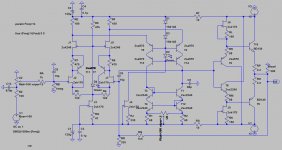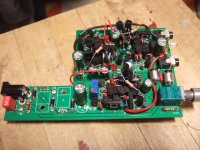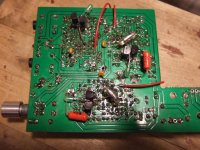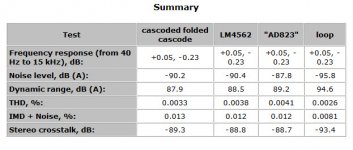It's been discussed, but I haven't seen it done so I had to try it. In spite of the messy appearance it's stable, low noise and measures well. Measured with RMAA THD is lower compared to the standard arrangement and mostly it's the 2nd harmonic that's reduced. I like the sound of it and think it's an improvement. It makes the sound cleaner and a little bit leaner.
Attachments
Looks like a nice headphone amplifier.
160mW of ClassA into your 300r phones.
Are j1 & 9 required?
160mW of ClassA into your 300r phones.
Are j1 & 9 required?
Last edited:
Not required but wanted. I've tried all four input stage concepts - standard, CFP, cascoded and CFP+cascode - and this it what I prefer.Are j1 & 9 required?
WuYit, yes it's probably esthetically displeasing but I like it. The standard common base VAS sounds a bit rough and muddy. The AD797-like arrangement and this sound better to my ears. I find it has about the same effect as cascoding the VAS in a LIN-type of amp.
Zen Mod, I can try it with a zener instead of the LED, but I't will be hard to tell if it's to the better. The amp adds very little to the sound (when I evaluate amps I usually add them to the signal path). What voltage would be appropriate?
some curious choices there
cfp around high current, low noise input jfet, setting the ~10mA Idss jfet Id at 1.5 mA, adding ~2-3x degeneration re the naked fet's 1/gm - both seem to say you actually don't trust the linearity/square law cancellation of the input jfet's themselves
the diff pair's "cascode" jfets add greater input Vgd 1/gm modulation than the drain R would without the folded cascode - I usually expect a added cascode to reduce the Vswing on the cascoded Q - leaving them out entirely would be better by that criteria
having used the cfp front end you don't use it where it would reduce distortion the most - in a Class A biased output stage
I would move the cfp to the cascoding jfets where the gm boost makes the cascode actually work to reduce input Vds change with common mode signal
and I would use cfp for the output - when used in Class A
and +/-12 V isn't enough for dynamic headroom and linearizing Vbias - I wouldn't want output device Vcb to go below 5 V - as long as it's a descrete circuit why not at least +/-24 V supplies? - with those jfet ccs on the output diamond buffer you need the extra bias V beyond usable output Vswing
at +/-12 Vsupply you could more easily just use an op amp
also I hate selecting parts so I would never use jfet ccs when a "ring of two" bjt feedback ccs just works, on less voltage, with greater output Z, the 1st time with the calculated values - no trimming
cfp around high current, low noise input jfet, setting the ~10mA Idss jfet Id at 1.5 mA, adding ~2-3x degeneration re the naked fet's 1/gm - both seem to say you actually don't trust the linearity/square law cancellation of the input jfet's themselves
the diff pair's "cascode" jfets add greater input Vgd 1/gm modulation than the drain R would without the folded cascode - I usually expect a added cascode to reduce the Vswing on the cascoded Q - leaving them out entirely would be better by that criteria
having used the cfp front end you don't use it where it would reduce distortion the most - in a Class A biased output stage
I would move the cfp to the cascoding jfets where the gm boost makes the cascode actually work to reduce input Vds change with common mode signal
and I would use cfp for the output - when used in Class A
and +/-12 V isn't enough for dynamic headroom and linearizing Vbias - I wouldn't want output device Vcb to go below 5 V - as long as it's a descrete circuit why not at least +/-24 V supplies? - with those jfet ccs on the output diamond buffer you need the extra bias V beyond usable output Vswing
at +/-12 Vsupply you could more easily just use an op amp
also I hate selecting parts so I would never use jfet ccs when a "ring of two" bjt feedback ccs just works, on less voltage, with greater output Z, the 1st time with the calculated values - no trimming
Thank you!the SK170bl runs best at app 5-7 mV and with app 12 V sving.....(my liking)
What is the appropriate voltage over a BJT, SC2362? I use it in the same manner as the SK170 in the ground channel input stage.
Nelson,
no, it is theoretically displeasing. The role of J1/J9 is exactly the same as that of T5/T2. Why devices with opposite characteristics? One of them is not suitable. Consequently, why don`t you want to cascode the input stage cascode as well?
There´s nothing that would make the standard common base VAS rough and muddy (when the voltage gain is kept at a reasonable level).
no, it is theoretically displeasing. The role of J1/J9 is exactly the same as that of T5/T2. Why devices with opposite characteristics? One of them is not suitable. Consequently, why don`t you want to cascode the input stage cascode as well?
There´s nothing that would make the standard common base VAS rough and muddy (when the voltage gain is kept at a reasonable level).
Member
Joined 2009
Paid Member
I've tried - standard, CFP, cascoded and CFP+cascode - and this it what I prefer.
I think this is great - it's DIY afterall, and instead of being lazy like me and some others around here, you have built something and tested it. Good for you!
I'd be interested to hear your thoughts on the relative differences between 'standard' and 'cfp' etc. not just which one you think is best.
As you clearly see I have no deeper knowledge and I appreciate your opinions.
Would it make more sense to use BJTs as cascode devices?
If this is all wrong, why does it have lower distortion both in real life and in sim?
I was aiming for constant power in both input stage and VAS like in this amp Memory Distortion Philosophies , only using a common base VAS because it's what I have at hand. If one believes in the "memory distortion philosophies", does it matter if the VAS is common base or common emitter?
Would it make more sense to use BJTs as cascode devices?
If this is all wrong, why does it have lower distortion both in real life and in sim?
I was aiming for constant power in both input stage and VAS like in this amp Memory Distortion Philosophies , only using a common base VAS because it's what I have at hand. If one believes in the "memory distortion philosophies", does it matter if the VAS is common base or common emitter?
I think this is great - it's DIY afterall, and instead of being lazy like me and some others around here, you have built something and tested it. Good for you!
I'd be interested to hear your thoughts on the relative differences between 'standard' and 'cfp' etc. not just which one you think is best.
These are my findings regarding input stages. Differences are subtle and subjective. It's not easy to describe differences in sound, and I guess we use different terms. The conditions are not optimal since I use lower voltage and current than most of you, but I can't hear any major differences between low and very low voltage, and between medium and low current.
BJT (BC550, SC2240, SC2362) vs JFET (SK170) - BJT: metallic, "solid state", clean, airy, large sound stage. JFET: rough, dirty, down-to-earth, more accurate sound stage
CFP JFET/BJT: cleaner than just JFET, darker sound, still much of the JFET charachter
Cascode JFET/JFET: cleaner than JFET, bright/lean sound, less JFET character
CFP+Cascode JFET/BJT/JFET: more neutral and natural, cleaner, even less JFET character
CFP BJT/BJT: warm, full and enjoyable but on the dark side of neutral
Cascode BJT/JFET: again a bit bright, clean and better than just the BJT but not as enjoyable as CFP
Nelson,
The voltage gain of the second stage is too high to my taste. Although this is a nice topology, two voltage amplifiers may be considered unnecessary in a (headphone) amp.
Yes. It would give you a pure transconductance / transimpedance compound, appropriate devices amplifying solely current respectively voltage.Would it make more sense to use BJTs as cascode devices?
The voltage gain of the second stage is too high to my taste. Although this is a nice topology, two voltage amplifiers may be considered unnecessary in a (headphone) amp.
Independently from the "memory distortion philosophy", the common base amplifier is far superior for voltage amplification.If one believes in the "memory distortion philosophies", does it matter if the VAS is common base or common emitter?
I incresed the voltage over the input transistors with no sonic difference at all, and it measures just the same.
Well, I guess you folks are right regarding cascoding the VAS or folded cascode. After some more listening I find the cascoded VAS to be anti-aggressive. At first I found it an improvement with less sibilance/solid-state-sound, and bad MP3-files sounding smoother. Now I think this is a coloration. I think it could be the same in common emitter VAS as well (I've done some experiments with my old Onkyo amps).
I think the perfect common base VAS is the AD797 type. It's simply more transparent and neutral than the standard one and the cascoded one. As for input stage I stand for my findings above.
Well, I guess you folks are right regarding cascoding the VAS or folded cascode. After some more listening I find the cascoded VAS to be anti-aggressive. At first I found it an improvement with less sibilance/solid-state-sound, and bad MP3-files sounding smoother. Now I think this is a coloration. I think it could be the same in common emitter VAS as well (I've done some experiments with my old Onkyo amps).
I think the perfect common base VAS is the AD797 type. It's simply more transparent and neutral than the standard one and the cascoded one. As for input stage I stand for my findings above.
Member
Joined 2009
Paid Member
I think the perfect common base VAS is the AD797 type. It's simply more transparent and neutral than the standard one and the cascoded one. As for input stage I stand for my findings above.
What is the AD797 type ?
several people have explored the AD797 bootstrapped current mirror "VAS" - some call such topologies "2-stage" claiming the folded casode doesn't count
http://www.diyaudio.com/forums/soli...omparison-seven-variations-2.html#post1883716
on the 1st page andy_c points to more detailed discussion elsewhere in the Blowtorch thread with Scott Wurcer (the AD797 designer) commenting
http://www.diyaudio.com/forums/soli...omparison-seven-variations-2.html#post1883716
on the 1st page andy_c points to more detailed discussion elsewhere in the Blowtorch thread with Scott Wurcer (the AD797 designer) commenting
Member
Joined 2009
Paid Member
Thanks - I see now that this is all differential, I was hoping for some insights into single ended cascoded VAS.
- Status
- Not open for further replies.
- Home
- Amplifiers
- Solid State
- Cascoding the folded cascode




